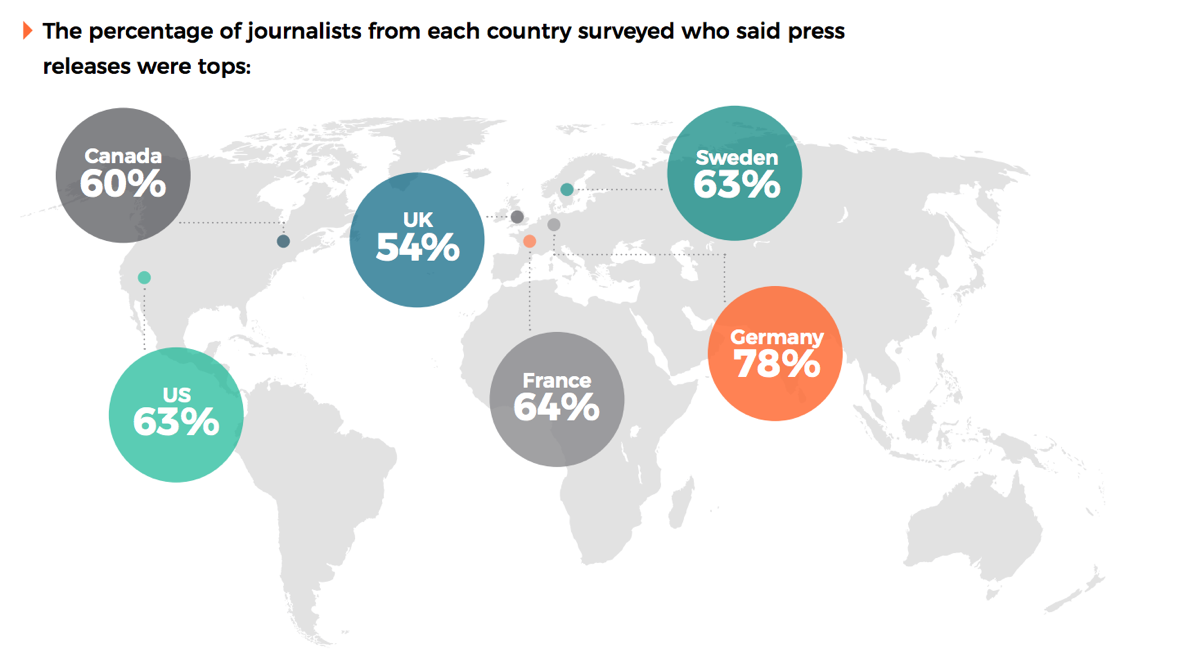As wild as 2017 was for journalists and media organizations in the U.S. and abroad, they successfully began to revitalize their position in society by relying on tried and true practices. Accuracy, ground-breaking stories and surprisingly, the press release, all played a vital role in aiding the media through 2017’s turbulent times. According to Cision’s 2018 Global State of the Media Report, which surveyed 1,355 journalists from across six countries on their perception of the media and communications industries, working with trusted PR professionals who can provide accurate, newsworthy information is a must.
Fake News Was Only One of The Major Challenges Journalists Faced in 2017
Subjected to constant badgering under a historically chaotic news cycle, in 2017, journalists and media organizations continued to do more with less. Prior to 2017, the shift to social media sucked much-needed resources from newsrooms worldwide, all while forcing journalists to learn how to promote their news on the social platforms. It was a hard year, but journalists and media organizations came out on top.
The biggest challenge of 2017 was an issue that has been plaguing newsrooms for much of the last decade, limited resources. 28 percent of respondents said staffing and resources were the biggest challenges in journalism over the last 12 months. The relentless news cycle may have made this issue more pronounced but ever since social media platforms began to move much-needed ad revenue from traditional publications, journalists have had to do more with less. One respondent summed it up nicely, “I continue to write news for bona fide news organizations, but I also promote my work where possible on social platforms. Having to master this piece is the biggest challenge where in the past writing news, getting it right and speedy publishing was enough.”
While the proliferation of fake news was a major challenge for journalists in 2017, it did bring some good with the bad. 59 percent of U.S. respondents think the onslaught of “fake news” makes people more skeptical about all kinds of content. The public’s new-found skepticism simply demands that journalists work harder to ensure the content they are publishing is accurate. That is why 78 percent of American journalists surveyed say that ensuring content is 100 percent accurate is the most important element to their stories in 2018. To add to the benefits of the fake news phenomenon, 21 percent of respondents said that it’s increasing the importance of journalistic standards, while nine percent said that it’s improving the popularity of trusted and established media brands.
While there is still a high level of distrust towards the media, it is clear that the relationship between the press and the public is improving. In fact, according to Edelman’s 2018 Trust Barometer, six out of ten people trust journalism, which is up five percentage points from last year. Cision’s 2018 Global State of the Media Report showcases that 71 percent of journalists surveyed feel people had lost trust in the media. While that’s still a troubling number, it is down from 91 percent in last year’s survey.
Journalists feelings aside, the revenue numbers do not lie. Traditional media outlets saw a major increase in traffic and revenue in 2017. In February 2018, The New York Times reported more than 10 percent year-to-year revenue growth for the fourth quarter of 2017 and 7.7 percent for the full year — a boon for an industry that had largely been in decline.
According to Poynter, The Times now has more than 2.6 million digital-only subscribers, 3.6 million including print and the verticals. Furthermore, AdWeek reported that cable news ad revenue grew a whopping 25 percent year-over-year. Once again, people see how important journalism can be with many critical stories impacting the way people think about politics, business and culture.
Journalists Continue to Rely on The Tried And True Press Release
When everything else in the media industry is being disrupted, journalists continue to trust press releases for high quality, authentic and relative information. Press releases come as a welcome respite to journalists, who cannot catch a break these days. Limited resources make every aspect of reporting difficult and sourcing credible information is one area where journalists desperately need assistance. As tested as the industry has been, one outcome from all the turmoil is that journalists need reliable public relations partners — perhaps more than ever before.
Cision’s 2018 Global State of the Media Report highlights that 20 percent said their relationships with PR pros have become more valuable, while 70 percent said it remained the same. Clearly, journalists rely on PR pros to provide key information for their stories. As far as how to provide this valuable information, 63 percent said news announcements and press releases are what they want from PR contacts.
This is the third year in a row that media professionals have ranked press releases and news announcements as the most valuable type content they receive from their PR contacts. And once again, they have chosen the press release as their most trusted brand source, with 44 percent saying press releases are the most trustworthy source of brand-related information. This is nearly universal, with journalists from around the world citing press releases as their most trusted source of company information.

Journalists have a lot to share on how to make press releases more effective, as well as the other types of content they need from PR professionals. Check out Cision’s 2018 State of the Media to learn more about today's biggest challenges for journalists.






